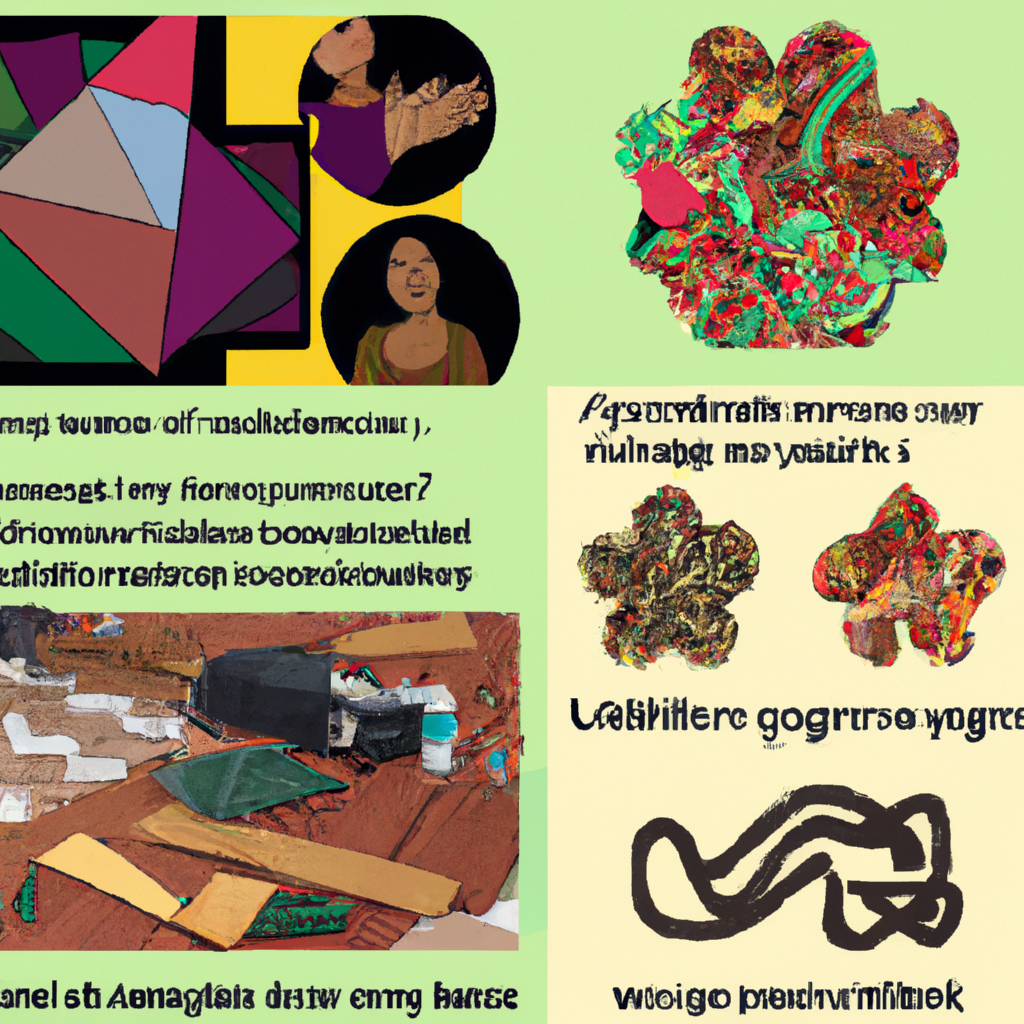Wouldn’t it be amazing if we could reduce waste and consumption while still enjoying the things we love? Well, that’s where upcycling comes in. Upcycling is a creative and innovative way of repurposing old or discarded items into something new and useful. By transforming unwanted materials into beautiful and functional objects, upcycling not only helps us reduce the amount of waste that ends up in landfills but also minimizes the need for new production processes. In this article, we will explore the question, “How does upcycling reduce waste and consumption?” So, get ready to learn how you can turn your trash into treasure and contribute to a greener future!

Check Out Our Top Eco Friendly Product Picks On Amazon Here
What is upcycling?
Upcycling is an innovative and creative approach to reducing waste and giving new life to old or discarded items. It involves transforming or repurposing products that may have otherwise been thrown away into something useful or valuable. Unlike recycling, which breaks down materials into their raw forms for manufacturing, upcycling focuses on finding new and creative ways to reuse existing products. It not only helps to minimize waste but also promotes sustainability by reducing the need for new resources and minimizing energy consumption.
Benefits of upcycling
Environmental benefits
Upcycling offers numerous environmental benefits, making it a sustainable choice for individuals and communities alike. By repurposing and reusing products, upcycling helps to reduce the demand for new resources and minimizes the environmental impact associated with manufacturing. It eliminates the need for the extraction of raw materials, the use of energy-intensive manufacturing processes, and the transportation of products. Additionally, upcycling decreases the amount of waste that ends up in landfills, preventing harmful pollutants and greenhouse gas emissions from being released into the atmosphere.
Reduction of waste
One of the primary benefits of upcycling is its significant contribution to waste reduction. Rather than discarding products and adding to the ever-growing mountains of waste, upcycling allows for the transformation of discarded items into new and useful creations. This not only decreases the amount of waste that is sent to landfills but also extends the lifespan of products, reducing the need for constant consumption and promoting a more sustainable lifestyle.
Conservation of resources
Upcycling plays a vital role in the conservation of resources by minimizing the extraction and consumption of raw materials. By repurposing and reusing existing products, upcycling reduces the demand for new resources such as timber, minerals, and fossil fuels. This, in turn, helps to protect natural habitats and ecosystems that are often destroyed by resource extraction. By conserving resources through upcycling, we can contribute to the preservation of our planet’s biodiversity and ensure a more sustainable future for generations to come.
Upcycling techniques
Repurposing
Repurposing is one of the most common upcycling techniques, involving the transformation of an item into something entirely different while retaining its original form or structure. It requires creativity and an eye for seeing the potential in objects that might otherwise be discarded. For example, an old ladder can be repurposed into a unique bookshelf, or a wine crate can be transformed into a stylish storage container. The possibilities for repurposing are endless, limited only by one’s imagination.
Refurbishing
Refurbishing is another upcycling technique that involves restoring old or worn-out items to their original condition or giving them a fresh new look. This technique is often used for furniture, where old wooden chairs, tables, or dressers can be sanded, painted, or reupholstered to create a brand new piece. Refurbishing not only extends the lifespan of furniture but also allows individuals to express their creativity and personal style.
Conversion
Conversion upcycling involves repurposing an item by transforming it into something entirely different from its original purpose. This technique often requires some level of customization or modification. For example, an old bicycle wheel can be converted into a unique chandelier, or a wooden door can be transformed into a stylish coffee table. Conversion upcycling showcases the ability to think outside the box and create functional and aesthetically pleasing items from unexpected materials.
Upcycling examples
Crafts and DIY projects
Crafts and DIY projects are a popular and accessible way to incorporate upcycling into everyday life. By utilizing materials that are readily available and using simple tools, individuals can create unique and personalized items. From handmade jewelry made with upcycled buttons to repurposing glass bottles into decorative vases, crafts and DIY projects allow for endless possibilities and a chance to showcase one’s creativity and resourcefulness.
Furniture
Upcycling can transform old or worn-out furniture into stunning and functional pieces. By applying simple techniques such as painting, reupholstering, or repurposing, furniture can be rejuvenated and given a new lease on life. For example, an outdated dresser can be repainted and given new hardware to create a stylish addition to any room. Upcycled furniture not only reduces waste but also allows individuals to create unique and personalized pieces that reflect their personal style.
Clothing and accessories
Upcycling is also prevalent in the world of fashion, where old or unwanted clothing and accessories are transformed into trendy and sustainable pieces. Through techniques such as patchwork, appliqué, or fabric manipulation, garments can be redesigned and repurposed to create one-of-a-kind fashion statements. For example, a pair of jeans can be transformed into a trendy denim skirt, or a collection of vintage scarves can be upcycled into a beautiful patchwork dress. Upcycled clothing and accessories offer a way to express individuality while reducing waste in the fashion industry.

Economic impacts of upcycling
Cost savings
Upcycling can offer significant cost savings for both individuals and businesses. By repurposing or refurbishing existing products, the need to purchase new items is minimized or eliminated entirely. This can result in substantial savings on both a personal and industrial scale. For individuals, upcycling can be a cost-effective way to furnish a home, decorate a space, or create unique gifts. In the business sector, upcycling can lead to reduced production costs, lower material expenses, and increased profitability.
Entrepreneurship opportunities
Upcycling has also opened up a range of entrepreneurship opportunities for individuals looking to turn their passion for creativity and sustainability into a business. Entrepreneurs can start small-scale upcycling businesses, creating unique products from discarded materials and selling them either online or in local markets. These businesses not only contribute to waste reduction and the circular economy but also provide economic opportunities and create local jobs. Upcycling entrepreneurship allows individuals to combine their creativity with their desire for a sustainable and profitable business venture.
Role of upcycling in sustainable fashion
Reduction of textile waste
The textile industry is known for its significant environmental impact, with vast amounts of waste generated from the production and disposal of clothing. Upcycling plays a crucial role in reducing textile waste by transforming old or unwanted garments into new and stylish pieces. By repurposing or converting clothing, upcycling extends the lifespan of garments and reduces the demand for new textiles. This not only decreases the amount of waste sent to landfills but also helps to conserve resources and mitigate the environmental impact of the fashion industry.
Circular economy
Upcycling is an integral part of the circular economy, a system that aims to minimize waste and keep products and materials in use for as long as possible. By repurposing and reusing clothing, upcycling contributes to the circular flow of resources, breaking the linear model of “take-make-dispose.” Instead, upcycling allows for the continuous use and transformation of materials, promoting a sustainable and regenerative fashion industry. By embracing the principles of the circular economy, upcycling reduces the need for constant consumption and supports a more sustainable and ethical approach to fashion.
Ethical consumption
Upcycling encourages ethical consumption by encouraging individuals to reconsider their relationship with clothing and accessories. By embracing upcycled fashion, consumers can support local artisans, independent designers, and small-scale businesses that prioritize sustainability and ethical practices. Upcycled fashion offers a unique and individualistic alternative to mass-produced garments, allowing individuals to express their style while making a positive impact on the environment. Through upcycling, consumers can make conscious choices that align with their values and contribute to a more sustainable and equitable fashion industry.

Upcycling in the food industry
Reduction of food waste
Food waste is a significant global issue, with millions of tons of food being wasted every year. Upcycling offers a creative solution to this problem by finding innovative uses for food that would otherwise be discarded. For example, overripe fruits can be transformed into jams or smoothies, and vegetable scraps can be used to make flavorful broths or stocks. Upcycling reduces food waste by utilizing ingredients that may not meet traditional aesthetic standards but are still perfectly edible, reducing the strain on landfills and minimizing the environmental impact of food production.
Creative culinary solutions
Upcycling in the food industry also encourages chefs and home cooks to think creatively and experiment with unique culinary solutions. By repurposing ingredients or using unconventional parts of fruits, vegetables, or meat, chefs can create innovative dishes that surprise and delight diners. For example, vegetable peels can be turned into crispy snacks, or fruit rinds can be candied and used as flavorful toppings. Upcycling in the food industry not only minimizes waste but also showcases the culinary creativity and ingenuity of chefs around the world.
Upcycling in construction and design
Building materials
Upcycling has made an impact in the construction and design industry by using discarded or salvaged materials as building components. By repurposing items such as reclaimed wood, old doors, or shipping containers, architects and builders can create unique and sustainable structures. For example, shipping containers can be transformed into eco-friendly homes, or reclaimed wood can be used for flooring or furniture. Upcycled building materials not only reduce waste in the construction industry but also contribute to the creation of distinctive and environmentally friendly spaces.
Architectural innovations
Upcycling has also led to significant architectural innovations, challenging traditional construction methods and materials. Architects and designers are exploring the possibilities of upcycling materials such as recycled glass, plastic, or metal in the construction of buildings. These innovative approaches not only reduce waste but also contribute to the energy efficiency and sustainability of structures. Upcycled architecture showcases the potential for creativity and sustainability in the construction industry, demonstrating that waste can be transformed into valuable resources.

Challenges and limitations of upcycling
Scale and efficiency
One of the challenges of upcycling is achieving scale and efficiency in larger systems or industries. While upcycling is feasible and effective on an individual or small-scale level, implementing it on a broader scale can be more challenging. Scaling up upcycling processes and infrastructure requires investment, coordination, and a reliable supply of materials. Additionally, achieving efficient upcycling processes that minimize waste and maintain quality can be complex, requiring technological advancements and specialized expertise.
Quality control
Maintaining quality control is another significant challenge in upcycling. Ensuring that upcycled products meet safety, functionality, and durability standards can be demanding, especially when working with a wide range of materials and techniques. Quality control becomes essential when upcycled products are intended for commercial use or when they need to meet specific industry regulations. Manufacturers and upcycling businesses must invest in product testing, certifications, and quality assurance processes to ensure that their products are safe, reliable, and perform as intended.
Limited applicability
Upcycling is not a one-size-fits-all solution and is not applicable to all materials or products. Some materials, such as certain plastics or electronics, may be challenging to upcycle due to their complex composition or lack of infrastructure for proper processing. Additionally, not all products can be easily transformed or repurposed without compromising their functionality or safety. While upcycling offers significant benefits, it is essential to recognize its limitations and explore alternative waste management strategies for materials or products that are not suitable for upcycling.
Promoting upcycling in communities
Education and Awareness
Promoting education and awareness about upcycling is critical to encouraging individuals and communities to embrace this sustainable practice. Educating people about the environmental benefits of upcycling, providing examples of successful upcycling projects, and offering practical tips and resources can inspire and empower individuals to incorporate upcycling into their daily lives. Schools, community organizations, and local governments can play a significant role in raising awareness about upcycling and providing resources and workshops to help individuals develop their upcycling skills.
Government initiatives
Government initiatives and policies can also play a vital role in promoting upcycling within communities. Governments can provide incentives or funding for upcycling businesses and entrepreneurs, create regulations that encourage the use of upcycled materials in construction or manufacturing, or develop campaigns that raise awareness about the benefits of upcycling. By prioritizing upcycling in waste management strategies and implementing supportive policies, governments can create an environment that fosters upcycling and promotes sustainable practices.
Collaborations and partnerships
Collaborations and partnerships between businesses, nonprofit organizations, and community groups can be instrumental in promoting upcycling initiatives. By working together, different stakeholders can leverage their expertise, resources, and networks to develop innovative upcycling projects and campaigns. For example, partnerships between upcycling businesses and retailers can create opportunities for the sale and distribution of upcycled products. Collaborations between artists, designers, and local communities can result in public art installations created from upcycled materials. Through partnerships, communities can create a collective impact and foster a culture of upcycling and sustainability.
How Does Upcycling Reduce Waste And Consumption: Future Possibilities
In recent years, upcycling has grown from a small-scale, niche trend into a significant movement, aimed at combating waste and promoting sustainable living. But what exactly does upcycling do to reduce waste and consumption? And how can this practice be expanded in the future to make even more substantial impacts on our environment and society? To answer these questions, let’s delve into the mechanics of upcycling and then explore its untapped potential.
What is Upcycling?
Upcycling involves taking waste materials or products that are no longer in use and transforming them into something new, valuable, and often more functional. Unlike recycling, which breaks down waste into raw materials before creating new products, upcycling adds value by creatively repurposing or refurbishing items.
How Does Upcycling Reduce Waste and Consumption?
- Diverts Waste from Landfills: Every item upcycled is one less item taking up space in a landfill. By repurposing items, we extend their lifecycle, thereby reducing the need for more landfills, which are hazardous for the environment.
- Reduces Production Emissions: New manufacturing processes often involve the emission of greenhouse gases. Upcycling minimizes the need for new products, reducing the carbon footprint associated with production.
- Conserves Resources: By reusing existing materials, we cut down on the need for new raw materials, thereby conserving natural resources such as water, minerals, and timber.
- Promotes Energy Efficiency: The production of new items requires energy for extraction, transportation, and processing of raw materials. Upcycling makes use of what’s already been produced, conserving energy in the process.
Future Possibilities: Expanding the Impact of Upcycling
Technological Advancements
- Automated Upcycling: In the future, automation and machine learning could identify optimal methods to upcycle different types of waste, improving efficiency and expanding the range of items that can be upcycled.
- Upcycling Marketplaces: As technology evolves, we could see the development of online platforms dedicated solely to upcycled goods, providing a space for both creators and consumers to connect.
Policy and Legislation
- Upcycling Incentives: Governments could offer tax benefits or subsidies for companies that engage in upcycling, motivating more businesses to adopt these practices.
- Educational Programs: Implementing upcycling as part of educational curricula can help ingrain the importance of sustainability in future generations.
Cultural Shifts
- Mainstream Adoption: As more people embrace the concept of sustainability, upcycling could move from being a ‘hipster trend’ to a mainstream practice, much like recycling is today.
- Collaborative Communities: In the future, community upcycling projects could become more widespread, encouraging communal efforts to reduce waste and consumption.
Innovative Business Models
- Upcycling as a Service (UaaS): Companies could offer upcycling services where they collect waste materials from consumers or businesses, upcycle them, and then return or resell the newly created products.
- Circular Economy Integration: More businesses could adopt circular economy principles, which naturally integrate upcycling as part of a larger strategy to eliminate waste and make the most of available resources.
As we look towards the future, it’s clear that the potential of upcycling to reduce waste and consumption is immense. Through technological advancements, policy shifts, cultural acceptance, and innovative business models, upcycling could significantly reshape our approach to sustainability, benefiting both the planet and its inhabitants.
How Does Upcycling Reduce Waste And Consumption: In A Nutshell
In conclusion, upcycling offers numerous benefits, ranging from environmental and economic to social and creative. By embracing upcycling techniques and practices, individuals and communities can contribute to waste reduction, conserve resources, and promote a more sustainable way of life. From repurposing old furniture to transforming food scraps into delectable dishes, upcycling showcases the power of creativity and resourcefulness in shaping a more sustainable future. Promoting education, government support, and collaborations can further accelerate the adoption of upcycling, inspiring individuals to reimagine waste as valuable resources and contribute to a more sustainable and circular economy. So next time you come across an item that seems destined for the trash, remember the possibilities of upcycling and give it a new life!
Check Out Our Top Eco Friendly Product Picks On Amazon Here




